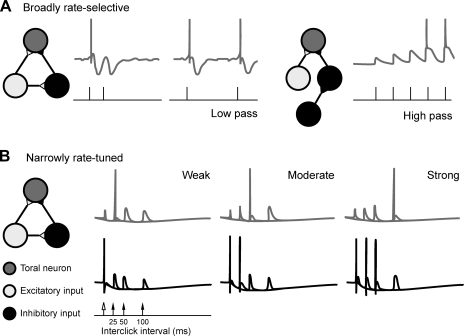Fig. 9.
A 3-neuron model for generating broadly or narrowly rate-selective neurons in the TS (cells in dark gray). The selectivity of the TS neurons relies on the circuitry: a monosynaptic excitatory input (cells in light gray) coupled to a disynaptic inhibitory input (cells in black) and various characteristics of short-term plasticity (e.g., facilitation) at the synapses in this circuit. A: generating broadly rate-selective neurons. Neurons selective for slow click rates (e.g., 6 Hz; stimulus amplitude in black and voltage in dark gray) are prevented from responding to faster rates by relatively long-lasting inhibition that follows initial excitation (left trace, after Oswald et al. 2006). Other neurons that select for fast click rates rely on facilitation after several clicks at a threshold rate (e.g., 35 Hz; right trace) and the absence of activity in the inhibitory pathway (due to a difference either in circuitry or in disinhibition). B: generating narrowly rate-tuned neurons. Selectivity for click rate can be generated by varying the strength of inhibitory (black traces) and excitatory input (not depicted; a spike locked to each click) to toral neurons (dark gray traces). Three traces are overlaid for three different interclick intervals. Weak input synapses cause the TS neuron to exhibit paired pulse facilitation that peaks at 25 ms (left). With a moderate increase of both inputs, a fast inhibitory postsynaptic potential prevents the TS neuron from firing until the 50-ms pulse (middle). Further strengthening of the input synapses leads to a response from the TS neuron exclusively to the second pulse at 100 ms attributable similarly to the recruitment of a slower inhibitory postsynaptic potential input (right). After Buonomano (2000).

